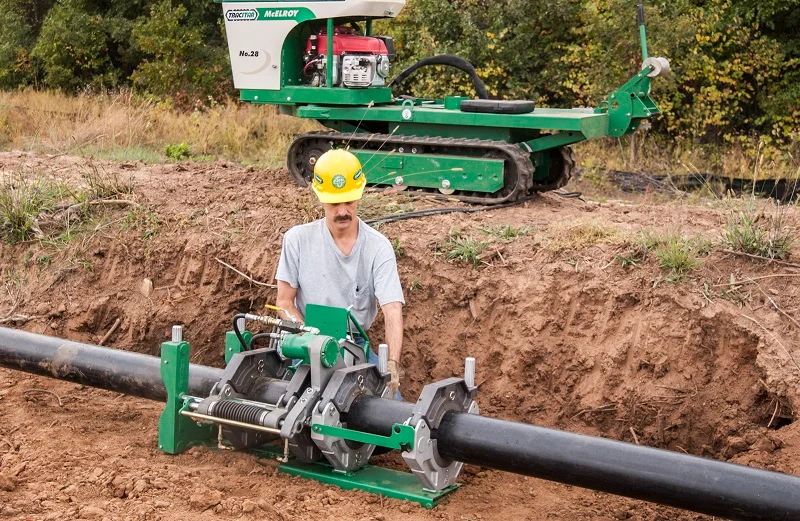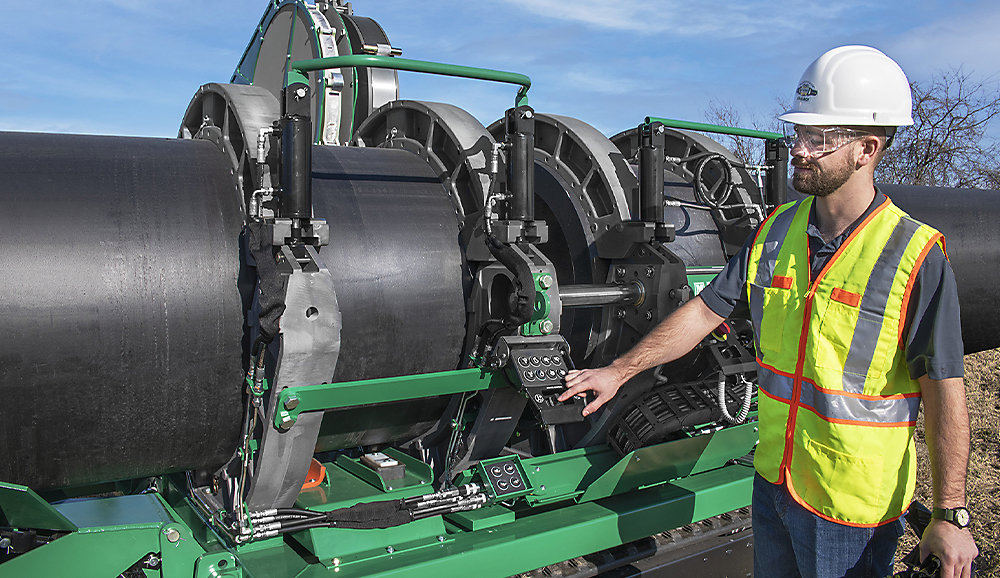What is butt fusion (hdpe welding) ?
Butt fusion is a thermofusion process
Butt fusion is a process by which the square cut ends of two
pipes or fittings of the same diameter, wall thickness and material type (PE80
or PE100), are fused together. It can be used to weld together pipes of 90 mm
OD (Outside Diameter) and higher. Smaller diameters are normally fusion welded
using electrofusion joints, though some technical specifications do allow pipe
of down to 63 mm OD to be butt fusion welded in carefully controlled conditions.
High quality butt fusion depends on the correct application
of temperature, time and pressure. If one of the three is not correctly applied
it will result in a sub-standard joint. When correctly carried out, the resultant
joint is fully resistant to end loads and therefore thrust blocks or
similar measures are not needed at bends, tees or to prevent the movement of
closed valves. The fusion joint has the same performance under pressure as the
pipe itself, effectively forming one long continuous pipe.
The butt fusion sequence can be broken down in to the
following principal steps. References to pipes also apply to fittings:
Cleaning: The pipe ends
are cleaned to remove physical contamination deposited during transport,
handling or storage and then placed in the welding machine. Cleaning should,
if possible, be undertaken using disposable lint free wipes containing at least
99% Isopropyl Alcohol (IPA). Wipes having a lower percentage of IPA (e.g. 70%)
should not be used as they leave moisture on the cleaned surfaces, which
interferes with the fusion process.
Clamping: Pipes are
clamped into the welding machine. One side is fixed and one side can move. Once
clamped, the ends are brought together to check the ovality of the pipe ends
and their alignment. Adjustments are made, if needed.
Trimming: The pipe
ends are pressed against a trimmer tool which planes the ends to remove
oxidised material or contaminants and ensure that they are smooth and parallel
to each other and the hot plate.
Alignment: After
trimming, checks are made that the pipe ends butt squarely against each other without
any gaps and that any offsets are within allowed limits. If the pipes are not
correctly aligned then their alignment must be adjusted and the ends trimmed
again, before alignment is again checked to ensure it is within the allowed
limits.
Heating: The pipe ends are pressed against an electrical
hot plate at a set temperature and pressure to form contact, after which heat
is allowed to soak into the ends of the pipes, melting them and forming a small
weld bead. The length of time for which the pipe ends are kept in contact with
the hot plate depends on the pipe diameter and wall thickness.
Fusion: Once the heating time is complete, the hot
plate should be removed and the pipe ends pressed together as quickly as
practical, to minimise the changeover time. This prevents significant cooling
of the ends, which could lead to a ‘cold joint’. The interface pressure at the
pipe ends is created and maintained by the welding machine's hydraulic system. It
will vary depending on which welding procedure is being followed. During this
process a weld bead is formed both on the inside and outside faces of the pipe.
Cooling: The pipe
ends and fusion joint are immobilised in the welding machine clamps whilst the material cools and reforms its
crystalline structure. Only then are they removed from the machine. The cooling
time mainly depends on the pipe diameter and wall thickness.
Debeading and testing: On
completion, the internal and external weld beads can be removed, if required. Non-destructive
tests can be applied to the weld bead and sometimes to the fusion joint itself to
assess the quality of each weld. Some technical specifications require the
cutting out and destructive testing of a small proportion (1 or 2%) of the
joints.

Butt fusion machine. Image courtesy McElroy Manufacturing
The use of automated welding
machines has increased in recent years, with the aim of improving the quality and consistency of
the fusion welding process. Machines can broadly be classified into three
groups:
Manual butt fusion: Involves
using machines where each step requires a manual intervention by the welder,
including the checking and maintaining of the welding pressures, the timing of
each phase and the recording of data. Such machines are now rarely employed,
but are occasionally used in less regulated applications such as irrigation.
Semi-automatic butt fusion: All
semi-automatic machines involve the use of computerised control systems that set
and maintain the hydraulic ram pressures to achieve the correct interface
pressure between the pipe ends and the hot plate whilst heating and then
between the two pipe ends during the fusion stage. Most semi-automatic machines
prompt the operator to undertake actions at different points in the fusion
process, based on a timer system. The hydraulic pressures and time periods are
based on the information fed in to the control system by the operator regarding
the pipes that are to be butt fused together.
Fully automatic butt fusion: These
machines, based on the information fed in to the control system by the operator,
fully automate the welding process from the heating of the pipes through to the
end of the cooling period. Some machines control the removal of the hot plate
themselves, whilst others instruct the operator when the hot plate has to be removed manually. Both semi and fully automatic machines will sound an alarm
if they detect something going wrong during the fusion process and will digitally
record such failures, together with many other parameters measured during
the operation. Such digital data can be downloaded on a regular basis or transmitted
through mobile phone networks etc.

Butt fusion machine. Image courtesy McElroy Manufacturing
The conditions under which PE pipes and fittings are welded
can have a considerable effect on the strength of the joint. To achieve a good
quality weld three elements are essential:
Cleanliness: Keeping
pipes and fittings clean is essential. Most injection moulded fittings come in
sealed plastic bags and these should not be removed until the fitting is about
to be placed in the welding machine. As described earlier, surfaces should be
cleaned with the proper IPA wipes. The welding machine should also be protected
against the weather in wet or dusty conditions, particularly when it is windy. Winds
can also cause the hot plate to cool and so in windy conditions the machine
should be protected by a tent or other enclosure.
Good practice: Many PE pipe
system owners require that people performing the butt fusion process have been
qualified though completing a recognised welder training course, together with
attending regular refresher training. Welders must then follow the good
practice that they have been taught, such as undertaking a dummy weld at the
start of each shift, to help ensure that the hot plate is clean. Some system
owners also require that the details of the joint such as time, date and
identity of the welder are recorded and also written on the pipe surface using
an indelible paint pen or similar device.
Maintenance, testing and certification: All
equipment must be maintained and tested in accordance with the manufacturer’s
instructions, together with being certified on a regular basis by the
manufacturer or an independent 3rd party organisation. Inspection
and testing should be undertaken by the operators on a regular basis. For
example, the heater plate, once it has reached its working temperature, usually
between 210 and 240°C, should have its surface temperature measured on both
sides of the plate around the full circumference expected to be in contact
with the pipe ends, to test that it is working correctly.
References
Butt-Fusion-Jointing-of-Polyethylene-Pressure-Pipes.pdf (teppfa.eu)
ISO 12176-1 : 2017 Plastics pipes and fittings - Equipment for fusion jointing polyethylene systems - Part 1: Butt fusion
ISO 21307 : 2017 Plastics
pipes and fittings - Butt fusion jointing procedures for polyethylene (PE)
piping systems
ISO 13953 : 2001 & Amd. No. 1 2020 Polyethylene (PE) pipes and fittings — Determination of the tensile strength and failure mode of test pieces from a butt-fused joint
Related keywords : hdpe pipe sizes, hdpe welding, what is butt, hdpe pipe fusion,butt fusion, butt fusion machine, hdpe pipe welding, how to fuse hdpe pipe, pe fusion machine, welding poly pipe, polyethylene fusion machines, hdpe pipe fusion specifications, plastic pipe fusion welding machine, polyethylene welding temperature, butt welding procedure, poly pipe welding course, hdpe fusion welding machine, butt pipe, weld polyethylene, welding hdpe pipe, hdpe pipe welder, pe welding machine, pipe fusion tools, hdpe fusion welding, hdpe welding machine, hdpe butt fusion, poly welding machines, hdpe pipe jointing method, hdpe welding procedure, hdpe pipe welding machine, fusion welding hdpe, hdpe pipe fusion welding machine, hdpe fusion, hdpe butt fusion welding machine, poly pipe welding machines, pe welding, hdpe pipe fusion machine, how to weld hdpe pipe, how to weld water pipe, butt fusion welding, fusion welding plastic pipe, how to join hdpe pipe, hdpe butt welding machine, how to weld hdpe

